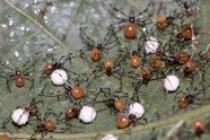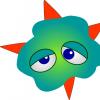Viruses appeared on Earth much earlier than humans and will remain on our planet even if humanity disappears. They are invisible, they cannot be heard or felt, but this does not mean that they are not there. Viruses live both inside and outside of us. We learn about their existence (if it is not our job to research viruses) only when we get sick. And here it turns out that this little thing, which cannot even be seen with an ordinary microscope, can be very dangerous. Viruses cause a huge spectrum of illnesses, from influenza and adenovirus infections to AIDS, hepatitis and hemorrhagic fever. And if representatives of other branches of biology in their daily work simply study their "wards", then virologists and microbiologists are at the forefront of the struggle for human lives. What are viruses and why are they so dangerous?
1. According to one of the hypotheses, cellular life on Earth originated after the virus took root in bacteria, forming a cell nucleus. In any case, viruses are very ancient creatures.
2. Viruses are very easy to confuse with bacteria. In principle, at the household level, there is not much difference. We encounter both those and others when we are sick. Neither viruses nor bacteria are visible to the naked eye. But scientifically, the differences between viruses and bacteria are very large. A bacterium is an independent organism, although it usually consists of one cell. The virus does not even reach the cell - it's just a set of molecules in the envelope. Bacteria cause harm sideways, in the process of existence, and for viruses, devouring an infected organism is the only way of life and reproduction.
3. Scientists are still arguing whether viruses can be considered full-fledged living organisms. Before entering living cells, they are as dead as stones. On the other hand, they have heredity. The names of popular science books about viruses are characteristic: "Reflections and debates about viruses" or "Is the virus friend or foe?"
4. Viruses were discovered in much the same way as the planet Pluto: at the tip of a feather. Russian scientist Dmitry Ivanovsky, researching tobacco diseases, tried to filter out pathogenic bacteria, but he failed. During microscopic examination, the scientist saw crystals that clearly were not pathogenic bacteria (these were accumulations of viruses, later they were named after Ivanovsky). The disease-causing agents died when heated. Ivanovsky came to a logical conclusion: the disease is caused by a living organism, invisible in an ordinary light microscope. And the crystals were able to be isolated only in 1935. American Wendell Stanley received the Nobel Prize for them in 1946.
5. Stanley's colleague, American Francis Rose, had to wait even longer for the Nobel Prize. Rose discovered the viral nature of cancer in 1911, and received the award only in 1966, and even then together with Charles Huggins, who had nothing to do with his work.
6. The word "virus" (Latin "poison") was introduced into scientific circulation in the 18th century. Even then, scientists intuitively guessed that there are tiny organisms, the action of which is comparable to the action of poisons. Dutchman Martin Bijerink, conducting experiments similar to those of Ivanovsky, called invisible disease-causing agents "viruses".
7. Viruses were first seen only after the appearance of electron microscopes in the middle of the 20th century. Virology began to flourish. Viruses have been discovered by the thousands. The structure of the virus and the principle of its reproduction were described. To date, more than 6,000 viruses have been discovered. Most likely, this is a very small part of them - the efforts of scientists are concentrated on pathogenic viruses of humans and domestic animals, and viruses exist everywhere.
8. Any virus consists of two or three parts: RNA or DNA molecules, and one or two envelopes.
9. Microbiologists divide viruses in shape into four types, but this division is purely external - it allows you to classify viruses as spiral, oblong, etc. Viruses also contain RNA (the overwhelming majority) and DNA. In total, seven types of viruses are distinguished.
10. Approximately 40% of human DNA can be the remains of viruses that have taken root in humans for many generations. In the cells of the human body, there are also formations, the functions of which cannot be established. They can also be ingrained viruses.

11. Viruses live and multiply exclusively in living cells. Attempts to introduce them like bacteria in nutrient broths have failed. And viruses are very picky about living cells - even within the same organism, they can live strictly in certain cells.
12. Viruses enter the cell either by destroying its wall, or by injecting RNA through the membrane, or allowing the cell to absorb itself. Then the process of copying RNA is started and the virus begins to multiply. Some viruses, including HIV, are taken out of the infected cell without damaging it.
13. Almost all serious human viral diseases are transmitted by airborne droplets. The exception is HIV, hepatitis and herpes.
14. Viruses can also be useful. When rabbits in Australia became a national disaster that threatened all agriculture, it was a special virus that helped to cope with the eared infestation. The virus was brought to the places where mosquitoes accumulate - it turned out to be harmless for them, and they infected the rabbits with the virus.
15. On the American continent, with the help of specially developed viruses, they are successfully fighting plant pests. Viruses harmless to humans, plants and animals are sprayed both manually and from airplanes.
16. The name of the popular antiviral drug Interferon comes from the word "interference". This is the name of the mutual influence of viruses in the same cell. It turned out that two viruses in one cell is not always a bad thing. Viruses can suppress each other. And interferon is a protein that can distinguish a “bad” virus from a harmless one and act only on it.
17. Back in 2002, the first artificial virus was obtained. In addition, more than 2,000 natural viruses have been completely deciphered and scientists can recreate them in the laboratory. This opens up wide opportunities both for the production of new drugs and the development of new methods of treatment, and for the creation of very effective biological weapons. An outbreak of a banal and, as it was announced, long-defeated smallpox in the modern world is capable of killing millions of people due to the lack of immunity.
18. If we evaluate mortality from viral diseases in a historical perspective, the medieval definition of viral diseases as the scourge of God becomes clear. Smallpox, plague and typhus regularly halved the population of Europe, destroying entire cities. The American Indians were not exterminated by troops of the regular army or by gallant cowboys with Colts in their hands. Two-thirds of the Indians died of smallpox, with which civilized Europeans were inoculated to infect the goods sold to the Redskins. At the beginning of the 20th century, from 3 to 5% of the world's inhabitants died from influenza. The AIDS epidemic is unfolding, despite all the efforts of doctors, before our very eyes.
19. Filoviruses are the most dangerous today. This group of viruses was found in equatorial and southern Africa after a series of outbreaks of hemorrhagic fevers, diseases in which a person quickly becomes dehydrated or bleeds. The first outbreaks were recorded in the 1970s. The average mortality rate for hemorrhagic fevers is 50%.
20. Viruses are a fertile topic for writers and filmmakers. The plot of how an outbreak of an unknown viral disease destroys a mass of people was played by Stephen King and Michael Crichton, Kir Bulychev and Jack London, Dan Brown and Richard Matheson. There are dozens of films and TV shows on the same topic.
19 facts you didn't know about viruses:
- Viruses are not living things. They don’t have cells, they don’t know how to convert food into energy, and without a “host” they are just small clumps of chemicals.
- Viruses, on the contrary, are not dead - they have genes, they reproduce, and natural selection processes operate for them.
- Scientists were confused to detect viruses until 1892, when the Russian microbiologist Dmitry Ivanovsky proved that the infection of tobacco plants occurs with the help of creatures much smaller than bacteria. These creatures turned out to be a virus, specifically a tobacco mosaic virus.
- American biochemist Wendel Stanley isolated the aforementioned tobacco virus in its pure form as needle-like protein crystals, for which he received the Nobel Prize in 1946 in the field of chemistry.
- Some viruses insert their DNA into bacteria through hollow hairs that are present in many bacteria.
- The word "virus" (virus) comes from the Latin word meaning "poison" or "dirty liquid", which is quite logical for the phenomenon that causes fever and colds.
- In 1992, scientists traced the source of pneumonia that broke out in England - it turned out that it was a virus hiding inside an amoeba living in the towers of a cooling tower. It was so large that at first scientists mistook it for a bacterium.
- The so-called mimivirus is so named because it mimics the behavior and structure of bacteria. Some experts believe that it is an intermediate link between bacteria and viruses, others are sure that it is a separate form of life. This virus is characterized by the most voluminous and complex DNA set of all viruses.
- In the body of the mimivirus there are more than 900 genes that encode proteins that are not used in other viruses. Its genome is twice as large as that of other known viruses and even bacteria.
- There are even larger viruses called mamavirus. They are larger than some bacteria, and these viruses also have satellite viruses called Sputnik.
- For viruses, amoebas are a kind of sandboxes and free canteens - they consume large objects within their reach and are a source of nutrients for bacteria that exchange genes with other bacteria and viruses inside the amoeba.
- Viruses can infect animals, plants, fungi, unicellular organisms and bacteria. Mamaviruses, together with the satellite, also infect other viruses.
- We may all be the result of the work of viruses, since a significant part of our genome contains "fragments" and whole parts of viruses that entered our ancestors millions of years ago, and were "domesticated".
- Many of the formations in our cells are at first glance useless, which is explained, among other things, by the fact that these are viruses that have safely taken root inside us at different stages of evolution.
- Most of the ancient viruses introduced into our genome do not exist in nature in our time. In 2005, French scientists began work to "resurrect" one of these viruses.
- One of the viruses resurrected in this way, codenamed Phoenix, turned out to be unviable. Apparently, not everything is so simple.
- Some viral fragments in our genome are apparently responsible for the autoimmune system and the development of cancer.
- We owe our very lives to viruses - some of the proteins encoded by viral DNA in the mother's body "adjust" the body's immune system so that it does not attack the embryo during development.
- We are all distant relatives on Earth. Scientists have reason to believe that a billion years ago, one of the viruses invaded a bacterial cell and from this a cell nucleus was formed, which subsequently led to the formation of a variety of flora and fauna, including you and me.




Many diseases are associated with viruses. Here are some interesting facts about viruses.
Let's notice right away that viruses are not living organisms.
The word virus originates from the term translated as poison, or contaminated liquid.

Without a carrier, viruses are just clumps of chemical elements. Due to their lack of cells, viruses do not have the ability to convert any food into energy.

Viruses are able to introduce their DNA into the body of bacteria through cavities in the hairs.

Among the extremely interesting facts about viruses, we note the funny ones. Chickens of the Araucana breed are capable of laying unusual eggs - they are bluish or salad. And the fault is the retrovirus, which infected these chickens. It inserts a gene into the host's DNA that causes an increased concentration of biliverdin, a yolk pigment, in the egg shell. It is interesting that this does not change the quality of eggs, they do not become more harmful or useful when compared with ordinary eggs.

Scientists have spent a lot of time in determining the ways of contracting pneumonia, which spread in Britain in 1992. It turned out that the virus then took refuge inside the amoebas that lived in the cooling towers located on the roofs used in air cooling systems. Since the virus was large, scientists initially took it for a pathogenic bacterium.

Large viruses are called mamaviruses. Their dimensions often exceed the size of even some bacteria. Such viruses have satellite viruses.

There is a widespread hypothesis that humans are the product of the work of viruses - a significant part of the human genome consists of "fragments" and even whole parts of viruses that have taken root in our ancestors. This happened a long time ago, for a long time this "cocktail" of viruses was "domesticated".

It is believed that some of the viral fragments in our genome are responsible for the autoimmune system and the prevention of cancer.

Without the participation of viruses, we could not be born - so that the embryo is not attacked during its development by the immune system, it is "corrected" by part of the proteins recoded by viral DNA right in the mother's body.

Now in nature, there are no most of the ancient viruses that once invaded our genome. For research purposes, scientists in France in 2005 began to "resurrect" some of these viruses.

But not everything turned out so easy. One of the newly "resurrected" viruses, called Phoenix, was revived unviable.

One of the most formidable diseases carried by the virus is Ebola. The first signs are considered to be fever, sore throat, severe headache and muscle pain. This often coincides with symptoms of a cold or flu. Then nausea, diarrhea appear, kidney and liver damage occurs, sometimes external and also internal bleeding.

Interesting video. Secret files about viruses.
The virus as a living being has a nucleus - it is a carrier of DNA, the structure is simple, the capsid is a protein shell, a lipoprotein layer. Many disease outbreaks are associated with viruses. The danger lies in the fact that viruses mutate, there are practically no drugs against them, the only effective method of fighting the virus is immunity. So you need to go in for sports, eat natural products, temper and it will be easier for the body to fight these small organisms, which are difficult to see even in an electron microscope. Here are some interesting facts about viruses.
Peculiarities
The formed virus, which is outside a living cell, is called a virion. The term "virus" is translated as "poison" or "dirty liquid". Viruses are sometimes considered biologically non-living organisms. They look like combined organic crystals. They can reproduce, this is evidence in favor of the fact that they are living beings, just their size does not allow for a more complex structure of the organism.

A medium-sized virus between a virus and a bacterium is called a mimivirus. Its DNA and behavior is similar to that of bacteria.
Major viruses are mamaviruses. They come more from bacteria. Mamaviruses can have satellite viruses.

If the bacterium can split on an artificial nutrient medium, then the virus needs a living medium. Viral cultures can only be grown in cells.
Viruses can exist for tens of thousands of years and then become active. In 2014, employees of Aix-Marseille University (France) managed to revive smallpox viruses found in the Siberian tundra, which are more than 30 thousand years old. Fortunately, this pathogen only affects amoebas. The very fact that pathogenic organisms can remain viable for so long makes scientists sound the alarm: the uncontrolled existence of viruses and bacteria of the most dangerous diseases is a reality. And this means that diseases that humanity seems to have dealt with can come to us again.

The virus is very small, which allows it to enter bacteria. Viruses infect unicellular elements, plants, animals. Viruses are unable to synthesize protein, a significant difference from bacteria.
In the event of an acute respiratory illness or influenza, the infection is transmitted by airborne droplets. Viral diseases include diseases that children often suffer from - chickenpox, measles, mumps, rubella.

Hepatitis A, B, C and other, more rare types of hepatitis have a viral origin. Hepatitis A (also called jaundice, due to the fact that the patient's skin turns yellow during the time of illness) is curable, the patient receives lifelong immunity.
In the case of a state of the art respiratory illness, flu infection is transmitted by a drip-drip. Ailments, which are often ailments for children, are often ailments of vitriol, cyr, mumps, rubella.

Virusne prokhodzhennya mє hepatitis A, B, C. Hepatitis A vilikovny, ailment otrimuє living immunity. Some forms of hepatitis are more important than those who are sick. People who have suffered a form of hepatitis cannot be blood donors.
There are viruses in the human body that have taken root well. For example, most people have the herpes virus and it manifests itself in the form of external signs only in the case of reduced immunity.

The papillomavirus can covertly exist in the body for a long time, making itself felt by papillomas, moles and warts. However, under certain circumstances, it can cause cancer. A factor that can cause cancer may be the transformation of papillomas into melanoma, thoughtless removal of papillomas is dangerous and can lead to an increase in the number of papillomas or their transformation into malignant ones.

Recently, vaccination against cervical cancer in women has been spreading, which supposedly should overcome the papilloma virus in the human body. Typically, the drug that is injected into the body is called Gardasil. However, it has many side effects - it can cause seizures, paralysis and other complications, and there have even been deaths after the administration of Gardasil. Also, vaccination against cervical cancer can provoke the cancer itself, that is, the vaccine not only does not help, but can seriously ruin health, be careful, refuse vaccination. The best practice for cervical cancer is a healthy lifestyle.

In 2012, a polio virus was created from non-living matter in a New York laboratory. Thus, for the first time, it was possible to synthesize a biological object. However, the fact of synthesis can be questioned, even though the polio virus is one of the most primitive. But the fact itself is alarming - scientists carefully guard the viruses of diseases, but perhaps they can be synthesized by intruders in the laboratory, especially since today the hereditary material (decoded DNA) of almost all dangerous viruses has been decoded and published - influenza, Ebola, smallpox and other causative agents of dangerous diseases.




Computer viruses were nothing more than a myth a few decades ago, but over the years the situation has changed dramatically. In modern days, malware has become a very powerful threat to governments and large international corporations, small businesses and individual computer users. There is no person in the whole world who would not risk being subjected to a cyber attack, no matter how powerful antivirus software is on his computer. But still, for each virus there is always protection in the form of antivirus software, in this article we will introduce you to the most terrible computer viruses of all time, but on shop.ico.kz you can learn more about antivirus security.

1. Creeper Virus

The very first computer virus was the Creeper Virus, which was discovered on the ARPANET, the predecessor of the Internet, in the early 1970s. It was an experimental self-replicating program written by Bob Thomas of BBN Technologies in 1971.
2. Viruses, worms and trojans

There are currently three main categories of malware threats: viruses, worms, and trojans. While their purpose and the way in which they cause harm are different, all viruses are built on the same principles.
3. Melissa

The Melissa virus (March 1999) was so powerful that it forced Microsoft and many other large companies to shut down their email systems. The corporate mail servers did not work until the virus was completely removed.
4. Dawn of the era of personal computers

Before computer networks became widespread, most viruses spread through portable storage media, particularly floppy disks. In the early days of the personal computer, most users regularly exchanged information and programs on floppy disks.
5. Viruses are illegal

However, the creation of a computer virus is not considered illegal in the United States today. Several other countries are implementing computer crime laws that are much stricter than the United States. For example, in Germany it is forbidden to exchange computer viruses, regardless of the reason, and in Finland it is even illegal to write a computer virus.
6. Cybercrime

Due to the constantly growing number of computer viruses and hackers, new types of computer crimes are emerging. These days, so-called cybercrime encompasses a wide range of occupations such as cyber terrorism, cyber extortion, and cyber warfare.
7. Losses - $ 38 billion

nter]
The most expensive computer virus of all time is the MyDoom worm, which was launched in January 2004. It caused losses of $ 38 billion. According to preliminary estimates, this virus infected 25% of all emails.
8. Anonymous

center]
In fact, it is very easy to become a member of Anonymous, the most famous international hacker network. But only a few members of this organization are elite hackers who can exploit security flaws in computer systems and write viruses.
9. Activation via link

You cannot get a computer virus just by reading your email. The virus is only activated by clicking on a link or by opening an infected attachment.
10. Frightening dynamics

By 1990, there were only about 50 known computer viruses. In the late 1990s, the number of viruses rose sharply to over 48,000. Today, about 6,000 new viruses are emerging every month.
11. Be careful, children!

Some virus writers are kids who create viruses just to test their programming skills. About 32% of all computers in the world (that is, almost every third computer) is infected with some kind of malware.
12. Antiviruses are not omnipotent

Despite the best efforts of researchers and developers in the field of computer security, currently none of the existing varieties of antivirus software is able to identify all computer viruses.
13. VBA Microsoft Office

Viruses can be written in various programming languages. The most popular are assembler, scripting languages (such as Visual Basic or Perl), C, Java, and macro programming languages (such as Microsoft Office VBA).
14. The wooden horse and the virus

Trojans, one of the three main types of computer viruses, are named after events from ancient Greek history. To be more precise, the creators had in mind the wooden horse, with the help of which the Greek troops secretly infiltrated besieged Troy.
15. ILOVEYOU

Created by Filipino programmers Rionel Ramones and Onel de Guzman in 2000, the computer worm known as ILOVEYOU, or "Letter of Happiness", has become one of the most dangerous computer viruses in history. The virus infected about 10% of the world's Internet-connected computers at that time. Losses of PC users around the world amounted to more than $ 10 billion.














